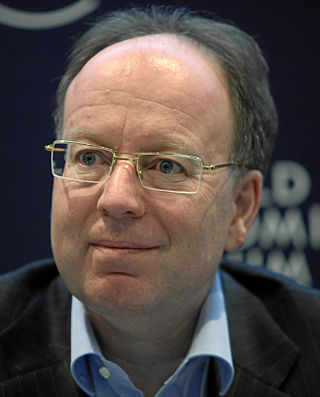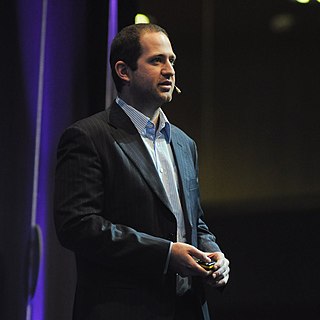
Authentication is the act of proving an assertion, such as the identity of a computer system user. In contrast with identification, the act of indicating a person or thing's identity, authentication is the process of verifying that identity. It might involve validating personal identity documents, verifying the authenticity of a website with a digital certificate, determining the age of an artifact by carbon dating, or ensuring that a product or document is not counterfeit.

The École Polytechnique Fédérale de Lausanne is a public research university in Lausanne, Switzerland, founded in 1969 with the mission to "train talented engineers in Switzerland".

École Supérieure de Chimie Physique Électronique de Lyon or CPE Lyon is a French grande école located in Villeurbanne, near Lyon.
Arun N. Netravali is an Indian–American computer engineer credited with contributions in digital technology including HDTV. He conducted research in digital compression, signal processing and other fields. Netravali was the ninth President of Bell Laboratories and has served as Lucent's Chief Technology Officer and Chief Network Architect. He received his undergraduate degree from IIT Bombay, India, and an M.S. and a Ph.D. from Rice University in Houston, Texas, all in electrical engineering. Several global universities, including the Ecole Polytechnique Federale in Lausanne, Switzerland, have honored him with honorary doctorates.

André Kudelski is a Swiss engineer of Polish descent, who is the Chairman of the Board and Chief Executive Officer of the Kudelski Group.

Michael Grätzel is a professor at the École Polytechnique Fédérale de Lausanne where he directs the Laboratory of Photonics and Interfaces. He pioneered research on energy and electron transfer reactions in mesoscopic-materials and their optoelectronic applications. He co-invented with Brian O'Regan the Grätzel cell in 1988.
Alain Wegmann was a Swiss computer scientist, professor of Systemic Modeling at the École Polytechnique Fédérale de Lausanne (EPFL), and Information Technology and Services consultant, known for the development of the Systemic Enterprise Architecture Methodology (SEAM).

Brand protection is the process and set of actions that a right holder undertakes to prevent third parties from using its intellectual property without permission, as this may cause loss of revenue and, usually more importantly, destroys brand equity, reputation and trust. Brand protection seeks primarily to ensure that trademarks, patents, and copyrights are respected, though other intellectual property rights such as industrial design rights or trade dress can be involved. Counterfeiting is the umbrella term to designate infringements to intellectual property, with the exception of the term piracy which is sometimes (colloquially) used to refer to copyright infringement.
The Faraday Medal is awarded by the Electrochemistry Group of the Royal Society of Chemistry. Since 1977, it honours distinguished mid-career electrochemists working outside of the United Kingdom and the Republic of Ireland for their research advancements.

The Lausanne campus or Dorigny university campus is a large area in Switzerland where the University of Lausanne (UNIL), the École polytechnique fédérale de Lausanne (EPFL) and several other institutions are located. It is in Dorigny, towards the west of Lausanne, on the shores of Lake Geneva. The site is about 2.2 kilometres wide and 31,000 people study and work there.
EuroTech Universities Alliance is an alliance of Technical University of Denmark, École polytechnique fédérale de Lausanne, Institut Polytechnique de Paris, Technion – Israel Institute of Technology, Eindhoven University of Technology, and Technical University of Munich. Founded in 2011, it aims to promote collaboration in research, education and innovation between European universities of science and technology. Today, the alliance focuses on five fields: artificial intelligence, additive manufacturing, health and bioengineering, sustainability, and entrepreneurship and innovation. The current president of the alliance is Robert-Jan Smits.
André Calantzopoulos is a Greek businessman. He is executive chairman of tobacco giant Philip Morris International (PMI), having previously been CEO. He worked as a design engineer in the automotive industry before joining PMI at 28 years old.

Vlad Trifa is a computer scientist, researcher and Chief Product Officer at Ambrosus who played a key role in defining and implementing the application layer of the Internet of Things. He is particularly known for his early contributions to the Web of Things along with other researchers such as Dominique Guinard, Erik Wilde and Friedemann Mattern. Vlad is widely published author and a recognized expert in distributed embedded sensing and interactive devices, and their integration with enterprise applications using Web technologies.
Sabine Süsstrunk is a computer scientist and professor at Ecole Polytechnique Fédérale de Lausanne (EPFL) in Switzerland, where she leads the Images and Visual Representation Lab in the School of Computer and Communication Sciences. Her research areas are in computational imaging and computational photography, color image processing and computer vision, and image quality and computational aesthetics. She is a fellow of the Institute of Electrical and Electronics Engineers and Society for Imaging Science and Technology and received the Society of Imaging Science and Technology and International Society for Optics and Photonics 2013 Electronic Imaging Scientist of the Year Award.

Mattia Binotto is a Swiss-Italian motorsport engineer. Formerly the team principal of Scuderia Ferrari in Formula One from 2019 to 2022, he has been the chief operating officer (COO) and chief technical officer (CTO) of Sauber Motorsport since 1 August 2024.

Erna Hamburger was a Swiss engineer and professor. In 1957, she became professor of electrometry at the University of Lausanne. She was the first woman in the history of Switzerland to be named a professor at a STEM university.
A copy detection pattern (CDP) or graphical code is a small random or pseudo-random digital image which is printed on documents, labels or products for counterfeit detection. Authentication is made by scanning the printed CDP using an image scanner or mobile phone camera. It is possible to store additional product-specific data into the CDP that will be decoded during the scanning process. A CDP can also be inserted into a 2D barcode to facilitate smartphone authentication and to connect with traceability data.

Scantrust is a Swiss company that provides an Internet of things platform for identifying products on the internet.
SwissCovid is a COVID-19 contact tracing app used for digital contact tracing in Switzerland. Use of the app is voluntary and based on a decentralized approach using Bluetooth Low Energy and Decentralized Privacy-Preserving Proximity Tracing (dp3t).
Mary Ann Ruth Mansigh Karlsen was an American computer programmer who was active in the 1950s in the use of scientific computers.











